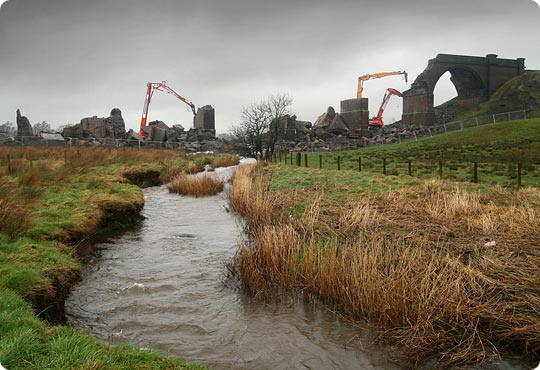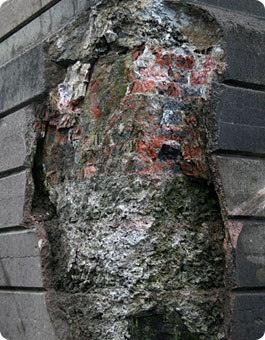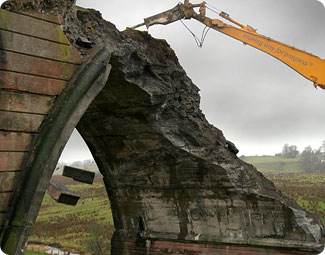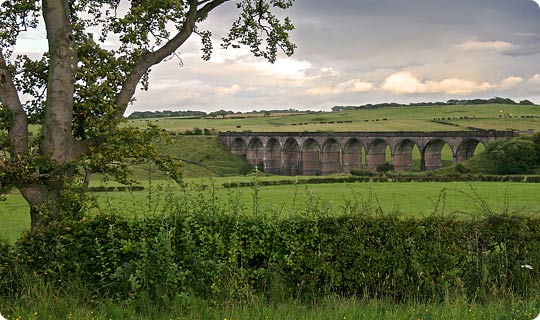The story of Gree Viaduct's demolition: Last Arch Standing

- Author: Graeme Bickerdike
- Source: Rail Engineer magazine
- Published: May 08
The story of Gree Viaduct’s demolition: Last Arch Standing
With the ravages of middle age securing an ever firmer hold, my part-financing of the National Health Service through 24 years worth of income tax payments looks an increasingly sound investment. That and my shares in Ralgex. It can only be a matter of time before some creaking body part completely gives up the ghost. The exterior finish already looks suspect.
Of course, society’s obligation to nurse and restore tired, crumbling relics only extends to human kind. Even listed buildings cannot always claim immunity from prudent financial stewardship. Witness the recent demise of Giffenmill Viaduct and its near-neighbour Gree, which grandly straddled Lugton Water – about 15 miles southwest of Glasgow – for over a century. The sense of melancholy is palpable with the benefit of rose-tinted spectacles.

Like its more famous, surviving relative at Glenfinnan, Gree helped to sharpen the cutting edge of structural technology, hence its Grade B listing. Both were offspring of locally-born engineer Robert McAlpine who earned the nickname of ‘Concrete Bob’ for his pioneering use of the material. The inaugural train tested Gree’s muscle in 1903, the same year that the world’s first reinforced concrete high rise broke the skyline in Cincinnati. But the 16-storey Ingalls Building was already a generation ahead of Ayrshire’s humble viaduct.
Cast concrete rings formed each of the 11 arches. A cement render, fixed with timber pegs and mimicking the appearance of traditional masonry, softened its impact on the local vista. But the mass aggregate infill – built-up in layers and comprising ample 300mm stone – lacked any of the steel reinforcement we’re familiar with today. This was a structure under huge tension and, contrary to the belief of its builders, was not resistant to the ravages of snow and rainfall.
Since its redundancy notice was served in the Fifties, a section of parapet wall had given way; refuges threatened to part company. Water had penetrated the carefully crafted façade causing spalling and movement through freeze-thaw. An ugly truth was revealed as the render fell – Gree was an accident waiting to happen. Sooner or later, claimed consultants Ove Arup and Partners, it would succumb to the inevitable and collapse.
This iconic monument served only a cosmetic purpose – no future function was realistically envisaged. Refurbishment would have proven costly – in excess of £1.2million – and problematic, given uncertainties over the precise make-up and strength of the structure. But when its owners, British Railways Board (Residuary), set the wrecking ball of demolition rolling in 2002, objectors’ heads soon rose above the parapet. Emotion clashed with logic, though the latter eventually won.

Gree’s first step towards destruction had actually been taken in May 1995 with the granting of listed building consent for the lion’s share of the structure, sitting to the west of Lugton Water. Administrative boundaries float above this watercourse, cutting the viaduct through its eighth arch. The project went nowhere as rail privatisation stole everyone’s attention.
Seven years on, BRB(R) lodged new planning applications with councils on either side of the water. A comparatively easy course was navigated through North Ayrshire’s processes but five more calendars had been torn from the wall before East Ayrshire reluctantly put its thumbs up. Legal agreements were prepared to secure passage for a possible footpath and negotiations concluded with landowners.
It was Christmas 2007 before Raynesway Construction – celebrating the award of another framework contract for the Board’s projects in Scotland and northern England – finally gained access to site. A compound was soon established which connected with the A736 via a 350 metre haul road. The burn was then spanned by a temporary bridge – providing access to the three eastern arches – as well as a crash deck fashioned from sheet piles, sleepers and timber supported on stone-filled bags. Plans to install a culvert were overruled by the Scottish Environmental Protection Agency which voiced concerns over its possible impact on breeding salmon. Assessments even took into account the possible presence of pearl mussels. There weren’t any.
With an exclusion zone established, Burnfield Demolition moved in with specialist excavators – one standard and two long-reach machines. BRB(R) policy demands that only companies approved by the National Federation of Demolition Contractors can raze its unwanted estate.

A long-reach hydraulic breaker beats the last arch into submission.
The north-side parapets were first to go. Then slices of deck and arch were chopped away along the structure’s length, narrowing it in stages. This gradually reduced the load, ensuring that residual forces would continue to be transferred from arch into pier. Cutting through a complete arch would have created the climate for an uncontrolled, progressive collapse, akin to the domino effect. Only when a 1.5 metre wide section remained was an arch finally knocked through.
The structure withstood this onslaught remarkably well, defying gravity on occasions. Nonetheless, when I visited site a fortnight after battle had commenced, just a solitary arch was still standing. In biblical rain and the wildest of gales, I watched hydraulic breakers beat it into submission. It was a surreal scene reminiscent of a disaster movie. I was half expecting Burt Lancaster to enter stage left, clawing through the wreckage for survivors. A handful of men, armed with the mechanical advantages of the 21st Century, reduced 9,000 cubic metres of concrete and a little piece of history to rubble in five weeks.
Fittingly, Gree is once again part of our transport infrastructure. Its considerable fabric was crushed, processed and stockpiled on site before relocating to East Kilbride where, today, it supports a roundabout. Its original home was green again in July. The access bridge and crash deck are gone; fences and drainage have been reinstated. Where recently there was only mud (much of it, as I discovered, slightly deeper than the average welly), graded top soil and grass seed now lie.

Ayrshire’s countryside has a new feature – a 211 metre window of fresh air, framed by two embankments. Given time, the many locals who bemoan Gree’s passing will see the natural beauty beyond. One of them paid a final pilgrimage to the viaduct shortly before it came down. His online recollections describe “a noisy gaggle of geese numbering over a hundred, flying from the south and circling back over this crowning landmark as if to salute this colossus of the steam railway age, and perhaps say a fond farewell to an old friend.”
Gree is gone but not yet forgotten.
More Information
| Beith.org | Personal recollections of Gree Viaduct |
| North Ayrshire Council | Planning application from April 2002 |
| North Ayrshire Council | Planning application from January 2004 |






